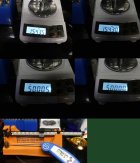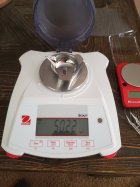The original point of this thread was to evaluate/eliminate differences in scales. Buying a better scale is one fix. Accepting the accuracy you have is another. Testing with really good weights is another.
Powder charge is one variable. Knowing charge variations are small enough to be considered insignificant WILL help downrange performance. I didn't think weighing primers had any merit until I saw actual test results. Various case and loaded cartridge dimensions are other variables. Compensating for environmental conditions and so many other things contribute to good or bad shots.
But, this is about accuracy of powder charge. If you survey the market, more $$$ is spent on charging than neck tension, trimming, and annealing combined. Someone thinks it's important.
My beam scale is as accurate as advertised. Pictured is a 10 gram (154.32 gn) on my beam scale indicating 154.3 gn, and my digital, tared and it flickers from 154. 30 and 154.35 gn, but in carats mode (5 carats = 1 milligram) it flickers from 50.000 and 50.005 ct.
The weight used was measured against an ASTM Class 1 10 gram standard with multiple transpositions to an accuracy of a little more than +/- 1mg. I also use 1 and 2 gram weights to check calibration for powder charges.
Hardly ever have to recaibrate the digital @ 50 grams. Scale factor seems to be very stable. This one example seems to be very repeatable. The scale will auto zero 1 or 2 counts, if zero indicates anything, I press the tare button. Charging 100 cases, with an extra 10 check weightings adds very little time.
My scales compare quite favorably. My measurement method detects/eliminates MOST drift. It takes a few seconds to periodically check the digital.
My issue with the beam scale is not with tossing a predetermined charge, but actually weighing something.
Sorting cases, bullets and primers with a beam scale isn't really practical.
Sounds like you need both.














